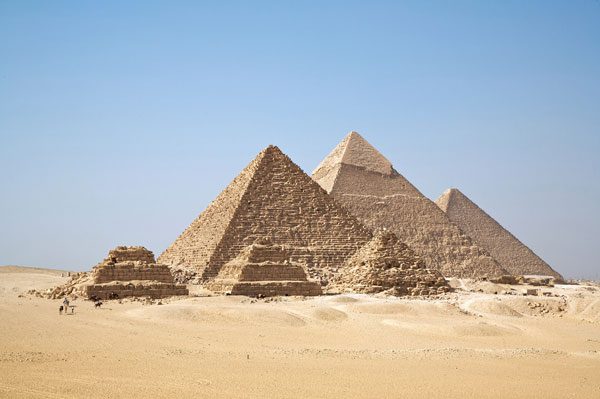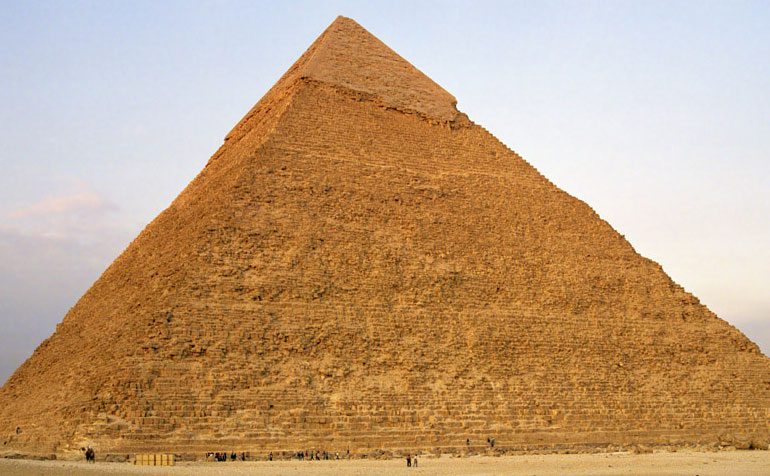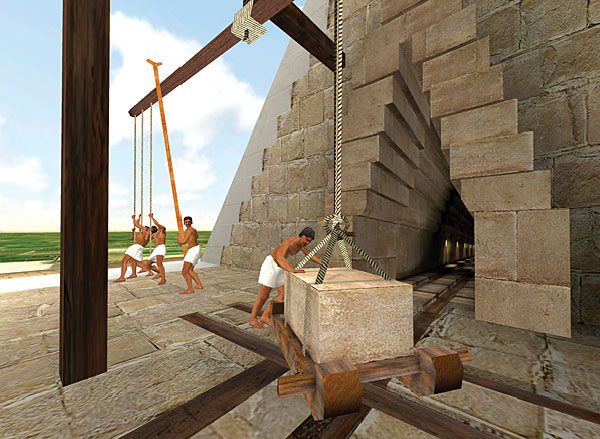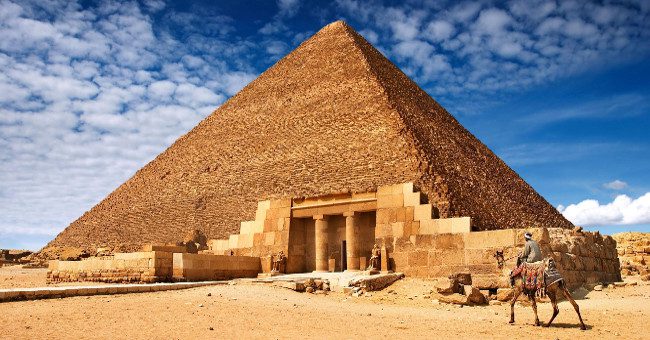If we had to choose the greatest and most mysterious architectural work of mankind, the Pyramids would undoubtedly be a strong contender. Along with mummies, the Sphinx, and the great pyramids of Egypt, these structures are favorite themes of movies, adventure stories, and horror tales. To this day, there has been no official, comprehensive, or accurate answer to the mysteries of the Pyramids. It is no coincidence that among the 7 wonders of the ancient world, the Great Pyramid of Giza stands at the highest position and is the last remaining wonder to this day.
How were the Egyptian Pyramids built?
What is a Pyramid?
A pyramid is a general term for structures with a square base and four triangular sides. In the minds of most of us, pyramids are solely associated with Egypt; however, this architectural form exists worldwide and is a product of many different cultures. Each culture has its unique characteristics and purposes for building pyramids.
For the ancient Egyptians, pyramids were constructed and used as tombs for their kings. These are also the most famous and mysterious pyramids of the ancient world. According to historical records, as soon as a king ascended to the throne, the first thing they would do is start building their own pyramid. Additionally, some legends suggest that pyramids were places where Egyptians protected their greatest secrets.

Each culture has its unique characteristics and purposes for building pyramids.
Next, we must mention the pyramids of the Mesopotamians, commonly known as Ziggurats. Ziggurats were part of the most sacred temples of the Mesopotamians.
The pyramids of the American civilizations, particularly the Maya, were used as places for human sacrifices to deities and are also noteworthy constructions.
Furthermore, other cultures such as Nigeria, Greece, Spain, China, Rome, India, and even Indonesia have their own unique pyramids. However, none can compare in grandeur and mystery to the Egyptian pyramids, which is why this article will focus on the tombs of the Pharaohs.
Why Did the Egyptians Build Pyramids?
According to recorded documents, the ancient Egyptians had a strong belief in resurrection and immortality. They believed that “in the dust of life, we are in death, so to welcome the living, we must prepare thoroughly.”
They meticulously prepared for their future death by placing great importance on building tombs because “a house is a temporary resting place, a tomb is eternal.” The pyramids were, in fact, the burial sites of the Pharaohs – the ancient emperors.
To date, 138 pyramids have been discovered in Egypt, all built on the west bank of the Nile River, the longest river in the world, spanning over 6,000 kilometers.

Egyptian Pyramids.
Among the pyramids in Egypt, the Great Pyramid of Khufu is the most magnificent, standing at a height of 146 meters, with a base length of 227.7 meters. To construct this monumental structure, over 2.5 million square meters of stone were used, with a base area of 52,198.16 square meters.
Even more astonishing to researchers is that despite the massive scale of the construction, the gaps between the two stone blocks do not exceed 5 mm, and the variation between corners ranges only from 8 to 15 cm.
This data demonstrates the intelligence and near-perfect precision of the ancient Egyptians. These pyramids were built over 5,000 years ago.
Why Are Egyptian Pyramids So Mysterious?
While other pyramid constructions have clear answers regarding how ancient peoples built them, the Egyptian pyramids remain a topic of much debate. Pyramids, without needing fictional stories, already present numerous mysteries concerning the scientific and technological advancements of ancient Egyptians.
The first point to mention is that the pyramids were constructed from solid natural stone blocks, without using binding materials like cement, as we do in modern construction. The stone blocks, which sometimes weigh several tons, were carved and joined together in a seemingly perfect manner, ensuring solidity, perfection, and endurance against the ravages of time. These blocks are held together solely by their weight. In fact, the largest and most famous pyramid in Egypt has survived for around 5,000 years. It is essential to know that the stone was not always sourced nearby; in some cases, it had to be transported from locations hundreds or even thousands of kilometers away. Moreover, how the Egyptians moved these massive stones into precise positions to complete the pyramids remains a mystery.

The pyramids also prove that the Egyptians knew about the number Pi.
Additionally, the pyramids demonstrate that the Egyptians understood the concept of Pi—a constant later attributed to Archimedes. The pyramids always maintain a very standard size ratio based on calculations involving Pi. For example, if we take twice the height of the Great Pyramid of Khufu and divide it by the base area, we arrive at the number Pi. This is considered the most efficient ratio for constructing such architectures. Furthermore, the precision of these pyramids is so meticulous that even with large, distinct stone blocks, one cannot slip a thin blade between the stones. At the Great Pyramid of Khufu, the height variation between two opposite edges is less than 2 cm—an astonishing accuracy given that the Egyptians lacked the precise measuring tools we have today.
Next is the Egyptians’ understanding of thermal effects and certain factors that science still cannot clarify today. The interior of the pyramids is believed to maintain perfect conditions regarding temperature and humidity, helping to preserve the mummies of the Pharaohs in the best possible state. Lastly, we must acknowledge the Egyptians’ remarkable knowledge of astronomy, constellations, and their exceptional orientation. By merely observing the stars, they achieved nearly absolute precision in orientation (with an error margin of less than 3 degrees).
How Were They Built?
First, it must be stated that the actual process of building a pyramid remains an unsolved mystery. All that we will discuss below are hypotheses that scientists consider most plausible regarding how these structures were constructed.
First, we must highlight the scientific consensus on how the Egyptians constructed the Pyramids. These great constructions were always initiated by Pharaohs immediately after they ascended to the throne, and it could take decades to complete a pyramid. During this time, a massive workforce was mobilized by the Egyptian kings to build their tombs. Generally, the workforce varied based on many factors: food supply, weather, wars, etc., but it is believed to have ranged from about 20,000 to 100,000 people working continuously. This workforce would be frequently replaced since building a pyramid was a grueling job that drained the health of these laborers. According to available documents, an average laborer could only serve for about three years at most.

Each stone block weighing between 2.5 and 8 tons was moved across rivers and hundreds of kilometers to the construction site.
The materials used in the Great Pyramid of Khufu were primarily sourced from quarries not far from the pyramid. However, the outer casing stones had to be retrieved from Tura, transported to the construction site. Each stone block, weighing between 2.5 and 8 tons, was moved across rivers and hundreds of kilometers to the construction site. Remarkably, this process relied entirely on human labor. Additionally, granite had to be sourced from Aswan, a location approximately 935 kilometers away from the construction site. It is estimated that moving one stone block would take about two months.
Of course, the ancient Egyptians could not drag these heavy stone blocks weighing several tons over such a long distance. Besides being extremely labor-intensive, these already-carved stone blocks would suffer serious damage. To tackle this, they used wooden sledges, pulled by ropes to the construction site. Nevertheless, even with this method, the effort required to move a stone was still considerable.
Raising the Stones
This is the most debated step in the construction of a pyramid. It’s important to remember that the Egyptians at that time did not have modern machinery to assist them. Even now, approximately 4,000 years after the completion of the Giza pyramids, lifting stone blocks weighing several tons to heights of tens of meters remains a significant challenge. So how did people, specifically the Egyptians, accomplish this task 4,000 years ago?
The first hypothesis, which is the simplest yet seems somewhat impractical to me, is that the ancient Egyptians used cranes and pulleys to lift these stone blocks. This hypothesis would make sense if the pyramids were built using bricks or smaller stones. However, for the pyramids, lifting blocks weighing around 2.5 tons seems quite difficult.
Firstly, if using a single pulley, we would need to provide a force equivalent to its weight. An average stone weighs 2.5 tons, and if each worker has a “lifting capacity” of 100 kg, we would need at least 25 people to pull one stone. Of course, this is an acceptable number. However, would those 25 people be able to continuously pull the stone upward? Additionally, the equivalent pulling force would be reduced several times if we used a double pulley (as illustrated in the diagram below). This sounds reasonable. However, how could we manufacture pulleys capable of withstanding such a massive pulling force is a challenging problem. Furthermore, once lifted, how would we position these stones accurately? This hypothesis does not seem very plausible.

How the ancient Egyptians transported stone to build the pyramids.
The second hypothesis, which is more widely accepted by scientists and certainly more reasonable, is that the Egyptians built massive earthen ramps to elevate the stone blocks. These ramps were constructed around the pyramid and were dismantled after completion. The earthen ramps significantly reduced the force required to lift the stones and also allowed multiple workers to pull them more easily.
Specifically, the Egyptians would construct a long, low-gradient ramp from the ground to the section of the pyramid that was under construction. Then, as they built higher sections, they would extend the ramp to maintain an appropriate gradient for construction. To pull the stones from the base of the ramp, they used rounded wooden logs to reduce friction. Work crews, varying in size depending on the stone’s dimensions, were mobilized in succession.
As they ascended, the ramp would need to be extended further, making the labor more arduous. However, fortunately for them, the number of stones at higher elevations would decrease over time. Estimates suggest that up to 96% of the materials were used in the lower two-thirds of the pyramid.
Naturally, there was not just a single ramp used, because if that were the case, constructing a pyramid would take centuries. In addition to 2 or 3 main ramps used continuously, smaller, auxiliary ramps were also built to transport as many stones to various parts of the pyramid as possible.

Estimates suggest that up to 96% of the materials were used in the lower two-thirds of the pyramid.
Construction and Completion
After raising the stones, the workers would position them correctly. The stone blocks were held together solely by their own gravity; the Egyptians did not use any binding materials. Depending on the pyramid and the arrangement of the stones, they created various internal structures. Generally, the internal architecture of the pyramids was designed with a common goal: to create pathways for the pharaoh’s soul to reach the stars.
Once the stones were placed to form the shape of the pyramid, the Egyptians would refine the exterior and interior surfaces of the pyramid until completion. The finishing work was performed from top to bottom. They would remove any protrusions from the pyramid’s surface, dismantle the ramps, and inscribe hieroglyphs on the interior of the pyramid…
The pyramids and the process of their completion remain a source of pride for the Egyptian people. The grandeur and wonder of the pyramids clearly reflect the skill and creativity of the Egyptians. To this day, the mysteries surrounding their construction remain a significant question for humanity.


















































